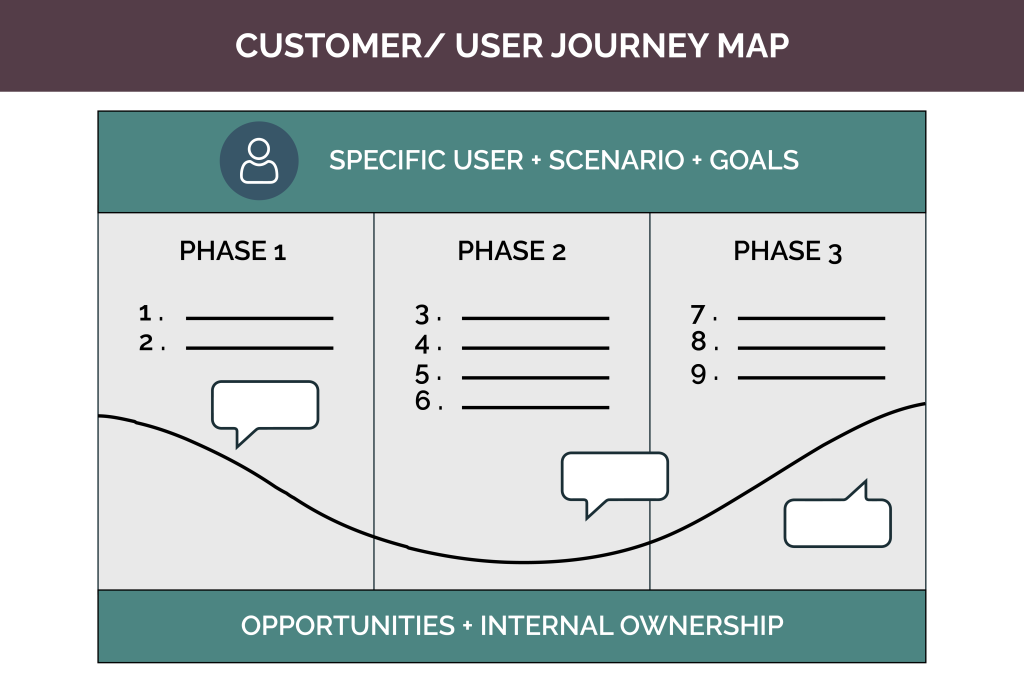Customer journey maps can be used to understand the relationship between a customer and a business over time. You can visualize the customer journey through the maps and track their interactions across all channels. Design teams can use customer journey maps to understand their customers’ experience, find out their customer expectations and identify areas where they can improve.
In this blog, we want to take a brief look at journey mapping to understand what it is, how it functions, and how it can be used to improve the experience you provide.
Tell customer stories
Journey mapping is about telling customer stories. They are research-based tools that provide designers with a clear narrative about their users that can improve the overall experience of all of their customers. With journey mapping, team members have the opportunity to examine tasks and interactions to determine whether their design fails to meet the needs of their customers. These maps should be rich with detail and indicate the most important tasks and events.
In general, a journey map should include:
- A timescale – a set journey period (e.g., one week or one month) that allows in-depth and sustained evaluation of the customer journey.
- Scenarios – the context and sequence of events, from first to last.
- Touchpoints – how the user interacts with your design.
- Channels – where the user interacts with your design and performs actions.
- Thoughts that arise from interactions – what the user thinks and feels throughout their journey.
The step-by-step process of user journey mapping
To ensure you get the most out of your user journey mapping, it’s essential to know the goals of your business, the intention behind your product, and your hopes for the future of the product. This will help you to align your aspirations with those of your users.
- Choose a scope – Do you want a user journey map that shows the end-to-end experience, or do you want a more detailed map that’s focused on a single interaction? that shows the end-to-end expertise or a more detailed map
- Create a user persona – Who is your user? Interview prospective users, understand the context around your users and analyze the results.
- Define the scenario and the user expectations – What is the situation you want to address? Is it actual or anticipated? What kind of expectations does the user have when interacting with your product?
- Understand your touchpoints – Create a list of touchpoints (user actions and interactions with the product)
- Understand user intention – What motivates your users to interact with your product?
- Formulate the journey – Make a sketch of the entire user journey and understand each step and interaction
- Understand the user during interactions – What does your user feel when interacting with your product? Considering their emotional state and their decisions will help you connect with them on an authentic, human level.
- Refine user journey – Ensure that your journey is realistic and relatable. Creating validated and refined user journeys is essential if the mapping process is valid.

Journey map variations
Several concepts are closely related to journey mapping. Let’s take a look at what makes them both similar and different.
Experience map
An experience map is far broader than a journey map. An experience map aims to understand general behavior, whereas journey mapping focuses on a specific product and a specific set of users. For example, an experience map can be used to know how you can solve a problem and isolate pain points.
On the other hand, a journey map can be used later on to take these pain points, assign them to a specific product and understand whether or not that product is meeting the customer needs. Therefore, to gain a complete understanding, you could use an experience map for the early stages and then a journey map later on.
User story map
User story mapping is a UX-mapping technique often used by Agile teams that helps plan features and functionalities. With user stories, mapping teams will sketch or use sticky notes to outline the interactions they want their users to go through to complete their goals with a digital product.
It is a helpful, visual way of condensing information and seeing everything from the user’s point of view. In general, the user story map is more about planning and implementation, whereas journey mapping is about discovery and understanding. With user story mapping, you could be more focused, specific, and detailed, whereas; journey mapping prioritizes the big picture and the whole customer journey.
Service blueprint
Service blueprints can function as extensions of journey maps. Suppose experience maps are the broad version of journey maps. In that case, service blueprints are the complete opposite: a focused method of visualizing specific components at touchpoints in a specific user journey.
A service blueprint can help you address what you do internally to support the customer journey. In every business, the nature of the service blueprint will differ, but, in general, it should provide a framework to understand each touchpoint and help you thoroughly examine specific customer journeys.
Success through journey mapping
With journey mapping, product managers, designers, and developers can gain a holistic view of the customer experience. They can uncover points of frustration, illuminate moments of ecstasy and really dig into why some interactions work and others fail. It is not a fool-proof system, but it simplifies the whole customer process. If done successfully, journey mapping reveals opportunities to address customer pain points and create an improved experience for your users.
Are you ready to start improving your users’ journey? If you’re curious about the next steps you should take, feel free to get in contact with our experts here at Radiant digital.

